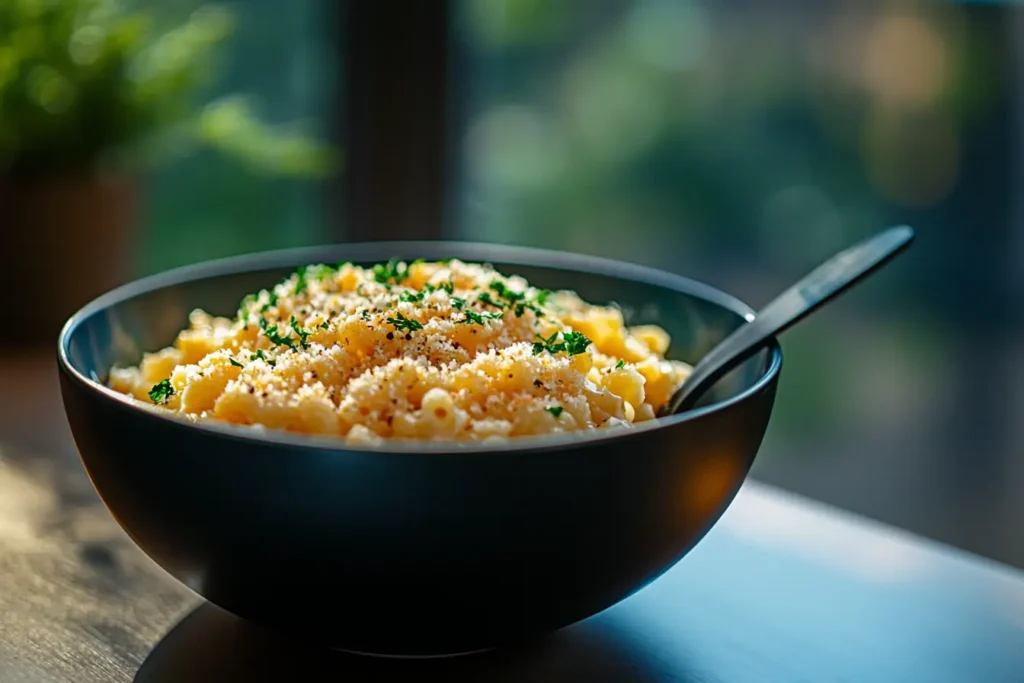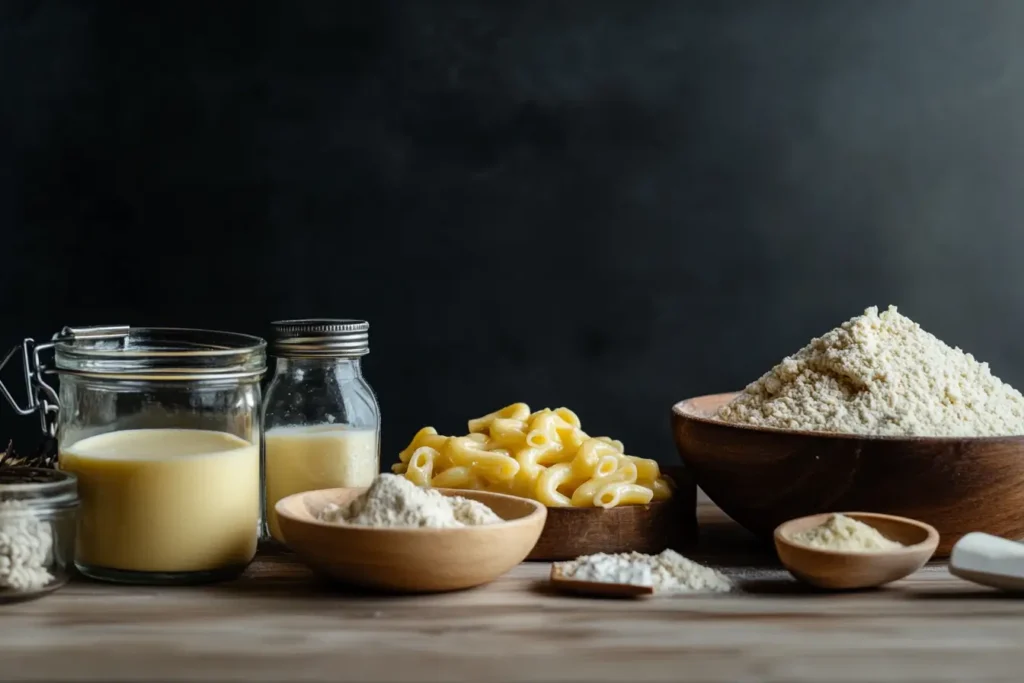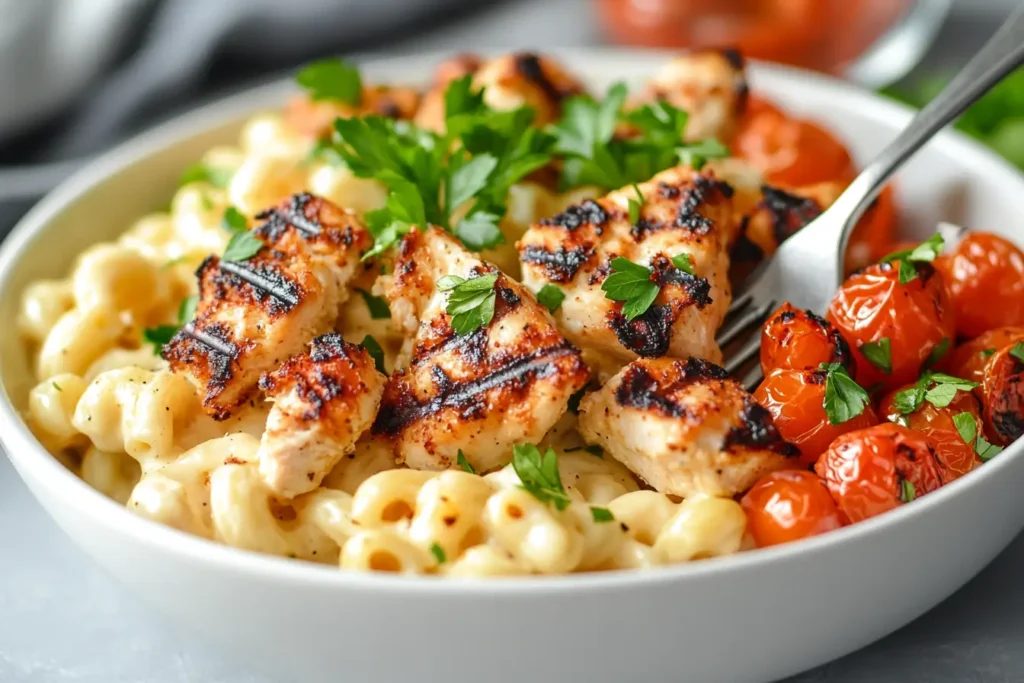
Table of Contents
Introduction:
Mac and cheese is the ultimate comfort food—rich, creamy, and oh-so-satisfying. But let’s be real… it’s not exactly the healthiest choice, especially if you’re trying to hit your protein goals. 😅
So, what if we could have it all? The gooey, cheesy goodness AND a solid protein boost? Enter: Protein Mac and Cheese—your new best friend in the kitchen!
This isn’t just another boring “healthy” version of mac and cheese. Nope. We’re talking about flavor-packed, high-protein, muscle-loving goodness that keeps you full without sacrificing taste. Ready to dig in? Let’s do this! 💪🍽️
The Problem: Traditional Mac and Cheese Lacks Protein
Classic mac and cheese? Delicious. Nutritious? Not so much.
The Nutrition Gap in Classic Mac and Cheese
Most traditional mac and cheese recipes rely on butter, milk, pasta, and cheese—which means lots of carbs and fats but not enough protein. Here’s a quick breakdown of a typical serving:
| Nutrient | Amount (per cup of classic mac and cheese) |
|---|---|
| Calories | ~300-400 kcal |
| Protein | ~10g |
| Carbs | ~40-50g |
| Fat | ~15-20g |
👀 See the problem? Not enough protein to keep you full and fueled!
Why Low-Protein Meals Can Be a Problem
When meals lack protein, you might find yourself:
✅ Getting hungry again way too fast.
✅ Missing out on muscle-building benefits (especially if you work out).
✅ Feeling sluggish instead of energized.
So, what’s the fix? More protein, same cheesy deliciousness! Let’s talk solutions. 😏👇
The Solution: How to Make a High-Protein Mac and Cheese
Time to level up your mac and cheese game! By making a few simple swaps and additions, you can turn this carb-heavy dish into a protein powerhouse. 🚀
The Best High-Protein Ingredients to Use
Instead of relying on just cheese, try these protein-packed swaps:
- High-Protein Pasta: Chickpea, lentil, or whole wheat pasta (packs 2-3x more protein than regular pasta).
- Greek Yogurt: Adds creaminess without the extra fat + bonus protein!
- Cottage Cheese or Ricotta: Blends smoothly for an extra protein punch.
- Lean Meats: Grilled chicken, turkey, or even tuna for added protein.
- Egg Whites: Stir in while cooking for a silky texture + extra protein.
“Think of protein as the glue that keeps you full and satisfied—without it, mac and cheese is just a cheesy excuse for a meal!” 🧀💪
Dairy vs. Non-Dairy Protein Options
Not into dairy? No worries! Here are plant-based ways to sneak in protein:
🥦 Nutritional Yeast: Adds a cheesy flavor + protein & B12.
🌱 Silken Tofu: Blends smoothly into the sauce (extra creamy!).
🥜 Nut-Based Cheeses: Almond or cashew cheese for a protein boost.
With so many options, there’s zero excuse to let your mac and cheese be weak on protein! 💪
Top Protein Sources for Mac and Cheese
Want to take it even further? Here are some of the best protein add-ins to supercharge your mac and cheese:
1. Lean Meat Additions: Chicken, Turkey, and Tuna
- Grilled chicken: Juicy, flavorful, 25g of protein per serving.
- Ground turkey: Cooks fast and blends into the sauce.
- Tuna: A classic protein bomb (great for creamy, cheesy casseroles).
2. Plant-Based Proteins: Lentils, Chickpeas, and Tofu
- Lentils: Earthy, chewy, and super filling.
- Chickpeas: Roasted or blended—either way, it’s a win!
- Tofu crumbles: Soaks up flavor like a sponge.
3. Protein-Packed Cheeses and Dairy Alternatives
- Cottage cheese: 14g protein per ½ cup!
- Greek yogurt: Creamy, tangy, and full of protein.
- Parmesan & cheddar combo: Because more cheese = more happiness. 😍
“Mac and cheese is like a blank canvas—get creative and load it up with protein!” 🎨💪
Step-by-Step Recipe: Ultimate Protein Mac and Cheese
Alright, time for the main event—a killer recipe that brings big protein, big flavor, and zero guilt.

Ingredients You’ll Need
✅ 8 oz high-protein pasta (chickpea or whole wheat)
✅ 1 cup shredded cheddar cheese (or vegan alternative)
✅ ½ cup cottage cheese or Greek yogurt
✅ 1 cup unsweetened almond milk (or regular milk)
✅ 1 tbsp butter or olive oil
✅ 1 tbsp nutritional yeast (optional, for extra cheesy flavor)
✅ ½ tsp garlic powder
✅ ½ tsp paprika
✅ Salt & pepper to taste
✅ Protein add-in of choice (grilled chicken, tofu, lentils, etc.)
Instructions
1️⃣ Cook high-protein pasta according to package instructions. Drain and set aside.
2️⃣ In a saucepan, heat butter over medium heat. Stir in garlic powder, paprika, and salt.
3️⃣ Add almond milk and shredded cheese, stirring until smooth.
4️⃣ Stir in cottage cheese (or Greek yogurt) + nutritional yeast.
5️⃣ Add cooked pasta + protein add-in of choice. Mix well until coated.
6️⃣ Serve immediately, topped with extra cheese or a sprinkle of paprika.
🔥 Boom! High-protein, creamy, delicious mac and cheese in under 20 minutes!
“Healthy food doesn’t have to be boring—this is proof that comfort food can be nutritious, too!” 💥
Nutrition Facts (Per Serving – 1 Cup)
| Nutrient | Amount |
|---|---|
| Calories | ~400 kcal |
| Protein | ~30g |
| Carbs | ~35g |
| Fat | ~12g |
Fun Variations: Creative Ways to Customize Your Protein Mac and Cheese
Mac and cheese is already a blank canvas for creativity, but when you add protein to the mix, the possibilities are endless! 🎨🧀
Whether you’re in the mood for something spicy, smoky, or packed with veggies, here are some amazing twists to take your Protein Mac and Cheese to the next level. 👇
1. Spicy Buffalo Chicken Mac and Cheese
Love Buffalo wings? Imagine that fiery, tangy goodness mixed into creamy mac and cheese! 🤤
How to Make It:
- Add shredded grilled chicken to the mac and cheese.
- Stir in 2 tbsp of Buffalo sauce and 1 tbsp of ranch dressing.
- Top with blue cheese crumbles for that extra kick.
- Garnish with chopped green onions for a pop of freshness.
“It’s like Buffalo wings and mac and cheese had a delicious, spicy baby!” 🥵💛
2. Vegan Protein Mac and Cheese with Cashew Sauce
No dairy? No problem! This plant-based version is just as creamy and packed with protein.
How to Make It:
- Swap out regular cheese for a cashew-based “cheese” sauce (blend cashews, almond milk, nutritional yeast, and lemon juice).
- Use chickpea or lentil pasta for extra protein.
- Toss in roasted chickpeas for a crunchy protein boost.
- Finish with a sprinkle of smoked paprika and fresh parsley.
“It’s so rich and creamy, you won’t even miss the dairy!” 🌿💚
3. High-Protein Mediterranean Mac and Cheese
This one’s for all the Mediterranean diet lovers—fresh, zesty, and packed with protein and flavor!
How to Make It:
- Use whole wheat pasta for a fiber boost.
- Stir in grilled chicken or tofu for protein.
- Add cherry tomatoes, black olives, and spinach for color and nutrients.
- Crumble feta cheese on top for a tangy twist.
“It’s like your favorite Greek salad met mac and cheese and became best friends!” 🇬🇷❤️
Common Mistakes and How to Avoid Them
Even the best chefs make mistakes! Here are some common pitfalls when making Protein Mac and Cheese—and how to fix them. 👀👇
1. Choosing the Wrong Pasta
Regular pasta is fine, but why not make it work harder for you?
Best High-Protein Pasta Options:
✅ Chickpea pasta – 14g protein per serving!
✅ Lentil pasta – High in fiber AND protein.
✅ Whole wheat pasta – A better choice than refined white pasta.
“Think of pasta as a vehicle—make sure it’s carrying extra protein to the destination!” 🚗💨
2. Overloading on Fat While Trying to Increase Protein
Cheese is amazing, but too much can turn your mac and cheese into a fat bomb instead of a protein boost.
Fix It:
- Use cottage cheese or Greek yogurt instead of heavy cream.
- Stick to lean protein sources like chicken, tofu, or legumes.
- Choose lower-fat cheeses like mozzarella or Parmesan instead of super heavy cheeses.
“You want PROTEIN power, not a fat overload!” ⚖️💡
3. Not Balancing Taste and Nutrition
Just because something is healthy doesn’t mean it has to be bland!
Fix It:
✅ Use seasonings like garlic powder, smoked paprika, mustard powder, or cayenne to boost flavor.
✅ Try different textures—crunchy toppings (like toasted breadcrumbs or nuts) make a BIG difference.
✅ Add veggies like spinach, mushrooms, or roasted red peppers for more variety.
“Healthy food should taste AMAZING—otherwise, what’s the point?” 🤷♀️💁♂️
Mac and Cheese Meal Prep: Making It Ahead for Busy Days

Want Protein Mac and Cheese on demand? Meal prep is the way to go! Here’s how to store, reheat, and keep it tasting fresh. 🍽️📦
How to Store and Reheat Without Losing Flavor
Refrigeration:
- Store in an airtight container for up to 4 days.
- To reheat, add a splash of milk or broth to restore creaminess.
Freezing:
- Freeze in single-serving portions for easy meals.
- Thaw in the fridge overnight before reheating.
Reheating:
- Stovetop: Add a little milk, stir, and heat on low.
- Microwave: Heat in 30-second bursts, stirring between each.
“A little extra care keeps your meal-prepped mac and cheese tasting fresh!” 💡👌
Health Benefits of Eating More Protein in Your Diet
We all know protein is important, but why does it matter so much—especially in a dish like mac and cheese? Let’s break it down! 🏋️♀️💡
1. How Protein Supports Muscle Growth and Recovery
Whether you’re hitting the gym or just staying active, protein is essential for muscle repair and growth.
- After exercise, your muscles break down and need protein to rebuild stronger.
- Mac and cheese alone? Not great for recovery.
- Protein Mac and Cheese? A game-changer—delicious AND helps fuel your fitness goals.
“Think of protein like bricks—your body needs them to rebuild and strengthen your muscles after every workout.” 🏗️💪
Pro Tip:
If you’re working out, aim for 20-30g of protein per meal to maximize muscle recovery.
2. Keeping You Fuller for Longer: The Satiety Factor
Ever eaten a bowl of regular mac and cheese and felt hungry again an hour later? That’s because it’s mostly carbs and fat, which digest quickly.
Protein helps by:
✅ Slowing digestion, keeping you fuller for longer.
✅ Reducing cravings, so you’re not reaching for snacks.
✅ Balancing blood sugar, preventing energy crashes.
“Protein is like an anchor—it keeps you steady and satisfied long after your meal.” ⚓🍴
Pro Tip:
Pairing protein + fiber (like whole wheat pasta or veggies) makes meals even more satiating!
3. Protein’s Role in Weight Management
If you’re watching your weight, high-protein meals can be a secret weapon!
- Boosts metabolism – Your body burns more calories digesting protein than carbs or fat.
- Reduces snacking – Keeps you full, so you don’t reach for unhealthy snacks.
- Preserves muscle mass – Helps maintain lean muscle while losing fat.
“More protein = better body composition. It’s like fuel for your metabolism!” ⛽🔥
Pro Tip:
Swapping low-protein meals for high-protein alternatives (like Protein Mac and Cheese!) helps manage hunger and cravings without feeling deprived.
Final Thoughts: Why You Should Try Protein Mac and Cheese Today
So, let’s recap:
✅ Classic mac and cheese? Delicious, but lacks protein.
✅ Protein Mac and Cheese? A high-protein, muscle-loving version that’s just as tasty.
✅ It’s easy to make, fully customizable, and works for meal prep too!
“Mac and cheese can be more than just comfort food—it can be a legit, muscle-fueling, satisfying meal!” 🏋️♂️💛
Call to Action: Try Your Own Version!
Now that you have all the tools, tips, and variations, it’s your turn to try it! 🎉
👉 Which version will you try first?
- Spicy Buffalo Chicken? 🔥
- Vegan Cashew Cheese? 🌱
- Mediterranean Feta & Olives? 🍅
Let me know in the comments below! 👇 Or better yet—share your own Protein Mac and Cheese creation! 📸✨
Extra Tips to Make It Even Better!
Want to take your mac and cheese game up another level? Here are a few more pro tips:
1. Add a Crunchy Topping for Texture
A little crunch goes a long way! Try:
✅ Toasted breadcrumbs 🍞
✅ Crushed nuts (almonds, walnuts) 🌰
✅ Crispy chickpeas 🤩
“That crispy topping makes every bite extra satisfying!” 🤤
2. Experiment with Different Cheeses
Not all cheese is created equal! Try mixing things up:
🟡 Parmesan – Sharp and nutty.
🟠 Smoked Gouda – For a rich, smoky flavor.
🟣 Vegan Cheese – Great for dairy-free options!
“Cheese is like music—blend different notes for the best harmony!” 🎶🧀
3. Use Broth Instead of Milk for Extra Flavor
Instead of just milk, try using:
🍗 Chicken broth – Adds depth to the sauce.
🌿 Vegetable broth – Keeps it light & flavorful.
“Small swaps make a BIG difference in taste!” 🎤🔥
Want even more mac and cheese inspiration? Check out this related recipe:
👉 Protein Mac and Cheese: Healthy Twist on Comfort Food
Final Words: Time to Enjoy!
Protein Mac and Cheese isn’t just a recipe—it’s a delicious, satisfying, high-protein meal that keeps you full, happy, and strong.
Now go grab your ingredients, get creative, and whip up your own protein-packed masterpiece! 🍽️💛
🚀 Ready to get cooking? Let’s do this! 🧑🍳🔥
